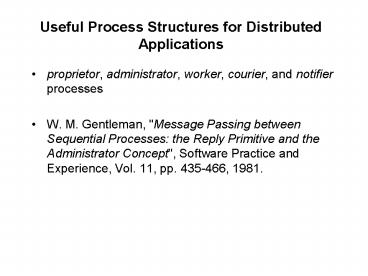Useful Process Structures for Distributed Applications - PowerPoint PPT Presentation
Title:
Useful Process Structures for Distributed Applications
Description:
proprietor, administrator, worker, courier, and notifier processes ... Courier Process. used to notify an administrator of the occurrence of some 'event' ... – PowerPoint PPT presentation
Number of Views:12
Avg rating:3.0/5.0
Title: Useful Process Structures for Distributed Applications
1
Useful Process Structures for Distributed
Applications
- proprietor, administrator, worker, courier, and
notifier processes - W. M. Gentleman, "Message Passing between
Sequential Processes the Reply Primitive and the
Administrator Concept", Software Practice and
Experience, Vol. 11, pp. 435-466, 1981.
2
Thoths Message Passing Primitives
- Send
- Sends a message to another process
- Blocked until a reply is received (also called
Request) - Receive
- Receives a message from another process
- Blocked until a message is received
- Reply
- Replies to a request
- Does not block
3
Courier Process
- convey information between two processes, neither
of which wishes to block - uses a pair of Sends
- no work performed
- code structure
- message null
- loop
- / message is from server /
- Send(message to client)
- / message if from client /
- Send(message to server)
- endloop
4
Notifier Process
- used to notify an administrator of the occurrence
of some event - blocks to event and then Sends message to the
administrator to notify - e.g., timer notifier
- code structure
- loop
- await_interrupt(timer tick)
- Send(message to server)
- endloop
5
Worker Process
- designed to do work on behalf of servers
- always Sends to server process
- reply message from server contains work
- initial Send would contain null result but
subsequent Sends would contain results of work - increases parallelism in servers
- code structure
- message null
- loop
- Send(message)
- do work
- message result
- endloop
6
Proprietor Process
- the simplest form of server
- processes messages in order received (which may
be different from order sent) - completes one request at a time ? limits
parallelism - e.g., disk server
- code structure
- loop
- Receive(request-message)
- process the request
- Reply(result)
- endloop
7
Administrator Process
- more complex form of server
- receives service requests from clients
- receives work requests from workers
- forwards clients requests to workers
- administrator itself does little or no actual
work - always Receives and Replies but never Sends
- only blocked when waiting for more service
requests by clients, or service completion from
workers - can reorder requests
- can be used to serialize a critical section
without restricting parallelism
8
- Administrator Code structure
- loop
- Receive(message)
- if (message from client)
- put request in work-queue
- else
- if (message from worker)
- Reply result to client
- get new request from work-queue
- Reply work to worker
- endif
- endif
- endloop
9
Example File System Process Structure
Operator_dialog
Device_ proprietor
Timer
Pathname_ administrator
. .
Couriers
From users
. . . . . .
. .
Freespace_ allocator
..
Drive_handlers
Backing_store _administrator
. .
(drive O)
From users
(drive I)
..
. .
(drive N)
10
Exercise
- How would the administrators algorithm be
changed if multiple workers were employed? - 1. If all workers performed the same work?
- 2. If workers performed different work?































